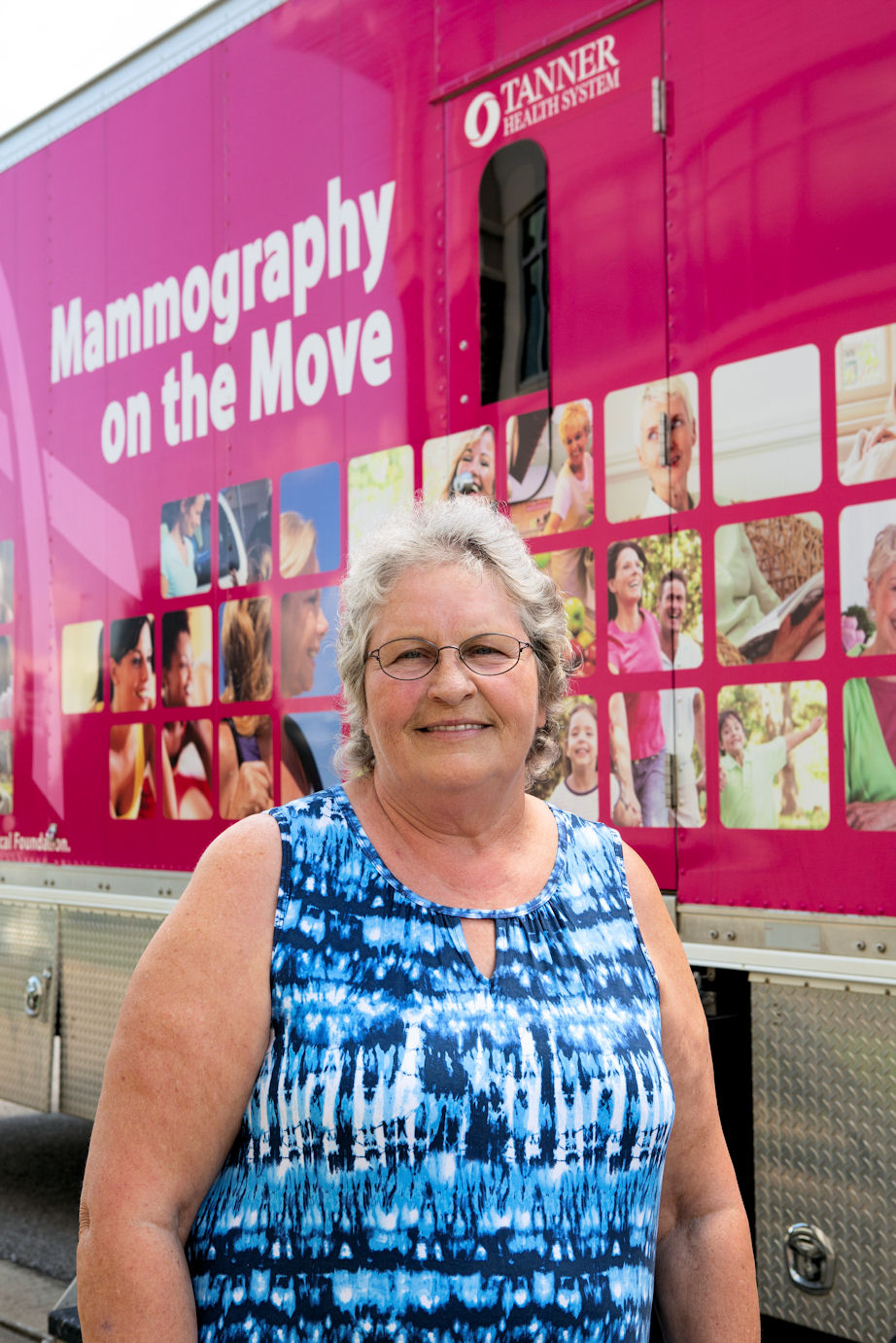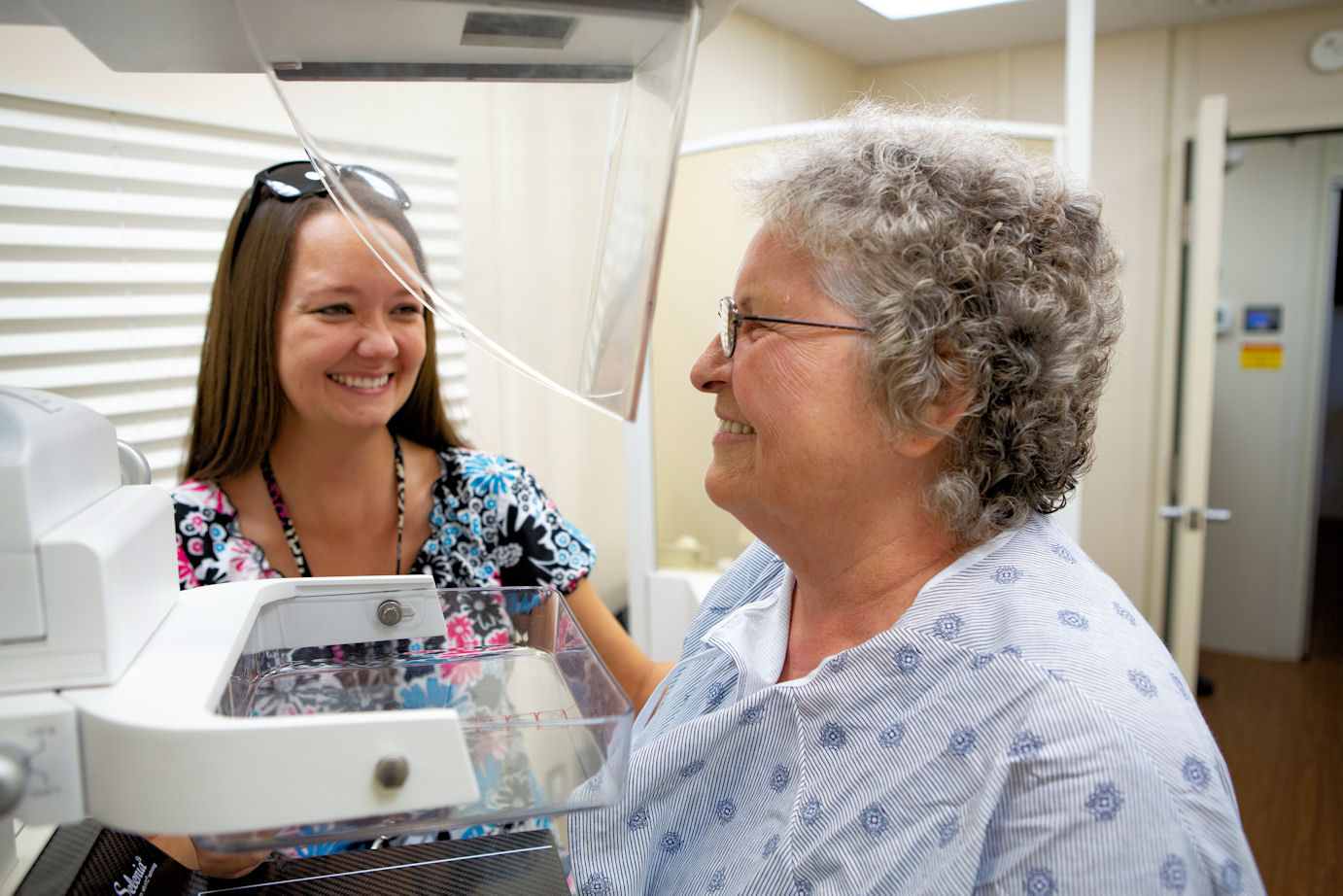Don’t be surprised to find Elsie Wilson pressure-washing her deck or taking down the mini-blinds to wash the windows — even though she only recently recovered from breast cancer.
The 66-year-old has bounced back to her normal life and is keeping busy after going through surgery, chemotherapy and radiation.

“I am getting back to my old self, and I am about as active as I was before cancer,” Wilson said. “I’m trying to get my house in order and do all the things I didn’t do when I was sick.”
In the summer of 2018, Wilson got a mammogram from Tanner Health System's "Mammography on the Move" mobile mammography unit when it came to Wedowee, Alabama.
The fully accredited, state-of-the-art digital mammography unit offers digital mammography and bone density screenings in comfortable, private, spacious surroundings.
Soon after, Wilson got a phone call saying there was something suspicious on her mammogram and she needed to come to the hospital for further evaluation. After a diagnostic mammogram, ultrasound and breast biopsy, she was diagnosed with stage I breast cancer.
“I was shocked at first,” Wilson said. “But you just have to deal with whatever is laid out to you in life as best you can.”
The Road to Recovery
Wilson’s treatment began with surgery. She also had a MammaPrint test.
“MammaPrint is a test that can show whether some estrogen receptor-positive (ER-positive), HER2-negative breast cancers are likely to spread to other organs,” said Raul Zunzunegui, MD, a surgical breast specialist with Comprehensive Breast Care Center and a Susan G. Komen Fellowship-trained, board-certified surgeon. “It is known as a tumor-profiling test because it analyzes a sample of a tumor that’s removed during a surgery or biopsy and tests it for 70 genes.”
Wilson said her MammaPrint test came back showing that her cancer was at high-risk for spreading. Having this information helped her doctors formulate the best possible treatment plan for her, she said.
Following her surgery, she had chemotherapy and then radiation.
Wilson, who worked for 38 years in a yarn mill, has always been strong and healthy. She said she wasn’t used to being a patient or spending time at a hospital.
“All of my doctors were great about explaining stuff to me so I understood what needed to happen,” she said. “My nurse navigator was always there for me, so I could call her if I thought of anything else afterwards or had a question at home.”
Her oncologist was Bradley Larson, MD, who is board-certified in medical oncology with Northwest Georgia Oncology Centers. Dr. Zunzunegui served as her breast specialist.
Wilson said she and her husband weren’t the only ones in the family who were pleased with the care at Tanner. Her cousin, a nurse, came along the day that Wilson had her port put in and started her chemotherapy.
“She was really impressed with how they took time to explain everything so well,” Wilson said.
A port is a device that is placed under the skin and has a thin tube that goes into a large vein. It stays in place for many weeks or months, making it much easier to administer medicines, such as chemotherapy drugs, intravenously and much easier to draw blood.
Biscuits and Chemo
Wilson had eight chemotherapy treatments that were given every two weeks through her port.
Wilson said she was surprised by how well her body handled the chemotherapy. She said she felt tired and nauseated, but never vomited.

She had her first day of chemotherapy on the same day that she had her port put in. Since the port was put in while she was under anesthesia, she hadn’t eaten since the night before and was very hungry.
“While I was getting my first chemo, I actually ate some biscuits and gravy,” Wilson said. “I thought I’d be sick, but I wasn’t, so I stopped for a hamburger on the way home.”
She says she realizes how lucky she was.
“I really didn’t have it as bad as a lot of people do, and I know how much harder it could have been,” Wilson said. “I just wish everyone who goes through it could have it like I did.”
Wilson lost her hair during chemotherapy but wasn’t bothered by it. She and her husband shaved her head when her hair began to fall out.
“I always had short hair anyway,” she said.
Wilson didn’t want to wear a wig, so she opted for a do-rag.
“My husband often wears a do-rag, so I just told him that we could be twins for a while,” she joked.
Her husband, Larry, who drove her to all her appointments and treatments, was a great source of strength and support, she said.
When it got cold, Wilson wore the crochet toboggan hats that volunteers make at Tanner for cancer patients.
“They have some nice colors and you can pick out the ones you like,” she said. “It kept my bald head warm in the winter.”
During chemotherapy, she stayed home as much as possible to avoid getting sick, as chemotherapy weakens the body’s immune system.
“I didn’t mind staying home,” she recalled. “A lot of times I was tired, so I would just sit in my recliner and rest.”
Wilson said she is grateful for her friends and family who were by her side during her treatment. Her sister lives nearby, as do her daughter and stepson.
“My family and friends would come and check on me, and I was lucky that I had a lot of people praying for me,” she said. “I knew I wasn’t doing this alone.”
Back to Normal
Nowadays she is simply enjoying life in Roanoke, Alabama, where she has lived her whole life.
“I like the peace and quiet of living in the country,” she said.
She is busy catching up on doing stuff around the house that got delayed during her cancer treatment. She is also helping her husband re-do the flooring in their rental property.
“My husband does most of the hard work, but I’m his ‘go-for,’” she said.

Reflecting on her experience, she said she hopes others who are diagnosed with breast cancer will have a positive experience like she did. She advises new patients to take it step-by-step to avoid getting overwhelmed at first by all the new information.
“All you can do is take it one day at a time,” Wilson said. “Don’t be afraid to ask questions if you don’t understand something because the doctors and nurses want to help you.”
Wilson also says that people facing cancer might find an unexpected silver lining in their experience. She sure did.
As someone who had straight hair her whole life and often got perms, she was very surprised when her hair grew back curly after chemotherapy.
“I really like it, and now I don’t have to fool with my hair anymore,” she said. “This is the first time in my life I ever got curl in my hair that I didn’t have to pay for!”
When asked what was the most important thing she could share with others she replied without pausing, “Everybody get your mammogram. Get it before you feel a bump. It might save your life.”